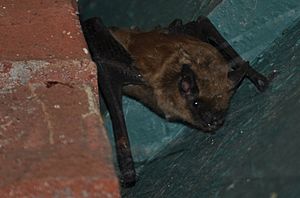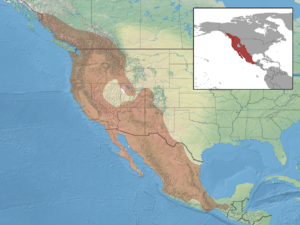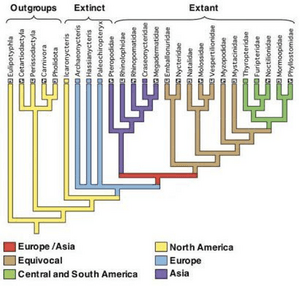California myotis facts for kids
Quick facts for kids California myotis |
|
|---|---|
 |
|
| Conservation status | |
| Scientific classification | |
 |
The California myotis (Myotis californicus) is a small type of vesper bat. These bats can be found in different parts of North America and Central America. They live in places like British Columbia in Canada, Guatemala, Mexico, and the western United States, including California.
Contents
What Does the California Myotis Look Like?
The California myotis is a small bat. It measures about 70 to 94 millimeters (2.7 to 3.7 inches) long. It weighs between 3.3 and 5.4 grams, which is about the weight of a few paper clips.
This bat has pale, dull fur. Its ears are medium-sized, about 12 to 15 millimeters (0.5 to 0.6 inches) long. Inside its ear, there's a narrow, pointed part called a tragus.
The California myotis has very small feet, only 5 to 7 millimeters (0.2 to 0.3 inches) long. It also has a clear keel on its calcar, which is a piece of cartilage that helps support the tail membrane.
It can sometimes be confused with the western small-footed myotis. However, the California myotis often has a slightly lighter face. Its tail also looks shorter, even though it's the same length. This is because the other bat's tail sticks out a bit more from the connecting membrane (uropatagium).
Teeth of the California Myotis
Like all bats, the California myotis has a special set of teeth. Its dental formula is: 2.1.3.33.1.3.3 × 2 = 38 This means it has 2 incisors, 1 canine, 3 premolars, and 3 molars on each side of its upper jaw. It has 3 incisors, 1 canine, 3 premolars, and 3 molars on each side of its lower jaw. In total, it has 38 teeth.
How Does the California Myotis Behave?
Daily Activities and Where They Live
During the day, California myotis bats like to rest, or "roost." They often find shelter in the bark of dead trees, especially ponderosa pines. They also use cracks in rocks or even buildings as their daytime homes.
These bats prefer to live in forested areas. You won't often find them in big cities or wide-open rural spaces. They usually come out to hunt for food just after the sun sets and just before it rises.
What Do They Eat?
The California myotis eats insects that fly. Their diet mainly includes moths, flies, and other flying bugs. They are slow flyers, but they are very good at moving around in the air. This helps them catch their prey easily.
Mating and Raising Young
California myotis bats usually mate in the fall. The females then give birth in the late spring, usually in May or early June. Each female typically has one baby, called a pup, per year. These bats can live for about 15 years in the wild.
When it's time to have their pups, female bats form small groups called maternity colonies. These colonies usually have about 20 bats. They often choose loose tree bark or rock crevices for these nurseries.
Male bats and females that are not having babies usually roost alone or in very small groups. During the winter, some California myotis bats might hibernate in mines or caves. Others might stay active all winter long.
See also
 In Spanish: Myotis californicus para niños
In Spanish: Myotis californicus para niños



